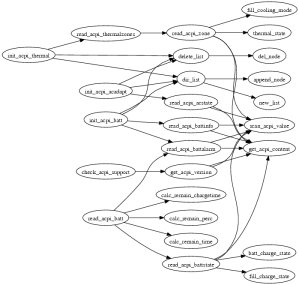Entries tagged as documentation
911 conspiracy random blurb truth announce acpi amd archlinux art ati cli clt code debian dell distributions dpl driver drivers events fglrx grml hacking hardware it crowd leader libacpi libs linux news newsbeuter open source openoffice partnership phrack programming release releases rss season 2 series soap software stfl text mode tools toy story wtf yacpi blogging config eyecandy flame google hacks podcast setup shell stuff tests tip user wordpress commands sus unix apache argh bash block build chroot dpkg fail2ban filesystem mutt network networking rant scponly security sftp spam ssh text tools tips trackback troubleshooting www zsh annouce awards conferences configuration convtroversy copyright debconf distributors dns eeepc errm errm? fail feature fix fud fun gcc gpl graphs icecast im images information installation keysigning kudos licenses maemo meetings mpd music n900 nitrogen notebook openbox opera packages pary patches privacy project qa review scripting scripts sofware squeeze streaming ubuntu vim.editing wallpaper web websites xinerama c compiler optimization monitoring munin openwrt community live cd survey wikipedia gsm mobile mobile phones osmocombb protocols 25c3 apple browser ccc congress companies ctf file system flagseverywhere functions ipod javascript pain pwnage radare reverse tricks 23c3 adobe binary cracking heise hex ii iptables irc nonsense noos passwords phishing ssl howto links power 9/11 data mining knowledge search engines toll collect wikileaks service applications archive arm cities conference copy&paste europe exploit features femtocell fosdem graphics hurd kernel myths ncurses paper presentation problems rms rsync services sfr solutions suspend terminal uberguru ubiquisys personal sms advertising faq pidgin testing w3c web security april biometry burger cool stuff darwin dhl dotcom filesharing firefox food games insults jokes linuxtag net culture stop-motion telephone telnet theory video youtube alerts analysis attacks backdoor bugs comments compromises dos dsa email exim fefe gpg key transition mail ntp omg ouch pdf pgp php pwsafe random thoughts suhosin vendors web 2.0 xing xss feed reader frustration help lazyweb netscape phone specs foobar bill bugmenot censorship comics dilbert flashsucks flickr piratebay retailmenot
Calendar

|
November '15 | |||||
| Mon | Tue | Wed | Thu | Fri | Sat | Sun |
| 1 | ||||||
| 2 | 3 | 4 | 5 | 6 | 7 | 8 |
| 9 | 10 | 11 | 12 | 13 | 14 | 15 |
| 16 | 17 | 18 | 19 | 20 | 21 | 22 |
| 23 | 24 | 25 | 26 | 27 | 28 | 29 |
| 30 | ||||||
Quicksearch
Support
Recent Entries
- E-Plus GSM privacy/TMSI allocation leak
- Thursday, October 11 2012
- Exploiting the Ubiquisys/SFR femtocell webserver (wsal/shttpd/mongoose/yassl embedded webserver)
- Wednesday, August 3 2011
- So what happened recently...
- Wednesday, April 6 2011
- Sunday, February 6 2011
- exim remote vulnerability
- Thursday, December 9 2010
- Will my Phone Show An Unencrypted Connection?
- Wednesday, September 8 2010
- smpCTF 2010 quals writeups
- Sunday, August 8 2010
- protocol design fail: MMS notification
- Wednesday, July 28 2010
- acrobat reader stealing my passwords
- Tuesday, June 29 2010
- UnrealIRCd backdoored
- Saturday, June 12 2010
Categories
Tag cloud
23c3 acpi advertising annouce announce april argh art awards bash blogging bugs c cli code conferences config configuration data mining debconf debian dell dns documentation email errm? events exploit fail fail2ban filesharing films flame fun gcc google graphs grml gsm hacking hacks hardware heise images information installation internet irc knowledge libacpi links linux mobile phones network news newsbeuter omg open source opera passwords php power privacy programming qa random blurb rant release releases rss scripts security service setup shell sms software spam ssh stfl stuff terminal tests text mode tip tips tools troubleshooting unix user video vim.editing web web 2.0 websites wordpress wtf www youtube zsh



